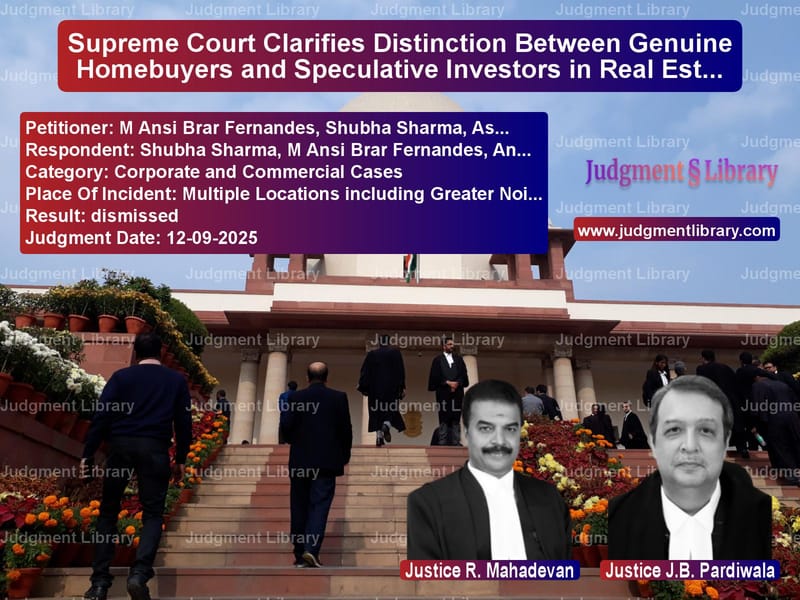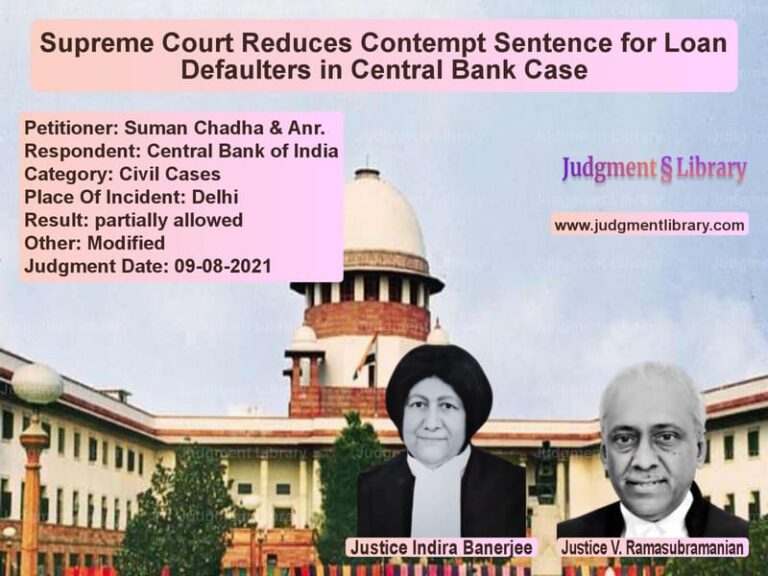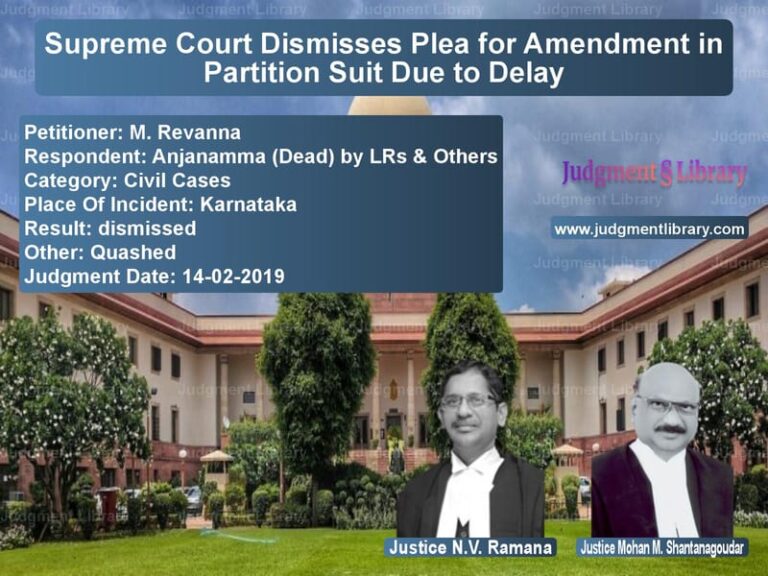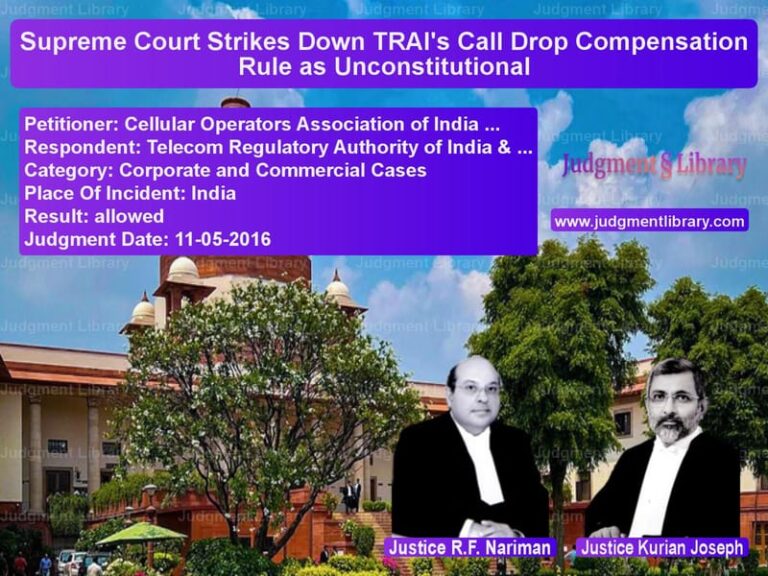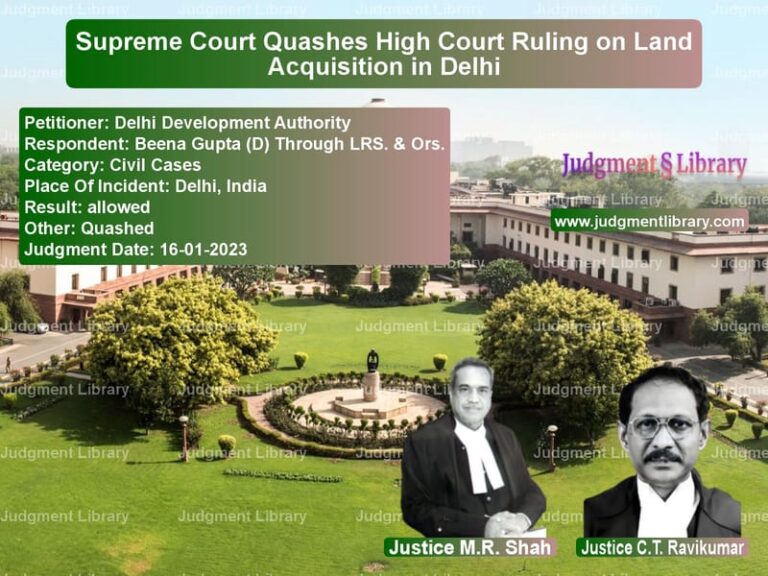Supreme Court Clarifies Distinction Between Genuine Homebuyers and Speculative Investors in Real Estate Cases
In a landmark judgment that has far-reaching implications for India’s real estate sector, the Supreme Court has drawn a clear distinction between genuine homebuyers and speculative investors, while emphasizing that housing is a fundamental right under Article 21 of the Constitution. The case involved multiple appeals concerning whether certain investors could initiate insolvency proceedings against real estate developers under the Insolvency and Bankruptcy Code (IBC), 2016.
The Complex Legal Battle
The legal proceedings involved four interconnected appeals dealing with similar issues regarding real estate investments and the invocation of insolvency proceedings. The primary appellants were Mansi Brar Fernandes and Sunita Agarwal, who had entered into Memorandums of Understanding (MoUs) with real estate developers Gayatri Infra Planner Private Limited and Antriksh Infratech Pvt. Ltd respectively. Both appellants claimed to be homebuyers and financial creditors under the IBC, seeking to initiate Corporate Insolvency Resolution Process (CIRP) against the developers for defaulting on their obligations.
The National Company Law Appellate Tribunal (NCLAT) had previously set aside the admission of their Section 7 IBC applications, holding that both appellants were “speculative investors” rather than genuine homebuyers. The NCLAT found that their transactions were structured as investment schemes with assured returns and buy-back clauses, rather than genuine home purchase agreements.
The Arguments Presented
The appellants argued vehemently that they qualified as financial creditors under Section 5(8)(f) of the IBC. Mansi Brar Fernandes contended that she had entered into an MoU dated April 6, 2016, for the purchase/buy-back of four apartments in the “Gayatri Life” project, paying Rs. 35 lakhs through cheque as part consideration. Her counsel submitted that “the MoU, which was commercially structured by the Corporate Debtor itself, contained a buy-back clause that was entirely at the option of the Corporate Debtor.”
The appellants emphasized that they had never withdrawn from the MoUs and were always willing to accept possession of the flats. They argued that the mere existence of buy-back clauses did not make them speculative investors, especially when these clauses were devised by the builders themselves.
On the other side, the respondents argued that the appellants were not genuine homebuyers but speculative investors who had entered into transactions “purely for assured financial returns and not for the purpose of acquiring residential property.” The Resolution Professional for Gayatri Infra Planner Private Limited submitted that “the MoU executed between the appellant and the Corporate Debtor included a buy-back clause offering the appellant an exorbitant return of Rs.1 crore on an investment of Rs.35 lakhs within 12 months, reflecting a commercial arrangement rather than a residential purchase.”
The Court’s Analysis and Key Findings
The Supreme Court delivered a comprehensive judgment that touched upon multiple aspects of real estate investments and insolvency law. The court began by explaining the fundamental objectives of the IBC, noting that “the IBC is a forum of last resort, intended to secure revival and completion of viable projects, not to serve as a debt recovery mechanism.”
In one of the most significant portions of the judgment, the court observed: “RERA remains the primary forum for redressal of homebuyers’ grievances; The IBC is a forum of last resort, intended to secure revival and completion of viable projects, not to serve as a debt recovery mechanism; and Consumer forums should confine themselves to adjudicating individual service deficiencies, thereby avoiding conflicting or overlapping orders across multiple fora.”
The court extensively discussed the concept of speculative investors in real estate, drawing from its earlier precedent in Pioneer Urban Land and Infrastructure Ltd v. Union of India. The judgment provided a detailed framework for distinguishing between genuine homebuyers and speculative investors, noting that “‘Speculation’ has been defined in P. Ramanatha Iyer’s Law Lexicon (6th edition) as ‘a risky investment of money for the sake of and in expectation of unusually large profits’. A ‘speculator’ is ‘one who practices speculation in trade or business’.”
The court further elaborated: “Two elements emerge: (i)expectation of unusually high profits; and (ii)activity in the nature of business or trade. These elements accord with the ratio of Pioneer Urban, which described speculative investors as those seeking refund or profit without an intention to occupy.”
Criteria for Identifying Speculative Investors
The Supreme Court provided a comprehensive set of indicators to help identify speculative investors, noting that “the determination of whether an allottee is a speculative investor, must be holistic, having regard to the terms of the agreement, the allotment letter, the payment terms, and the overall conduct of the allottee.”
The non-exhaustive indicators included: “(1) If the agreement substitutes possession with a buyback or refund option, or any other special arrangement, the allottee is likely a speculative investor. (2) Insistence on refund with high interest, coupled with refusal to accept possession would indicate speculation. (3) Purchase of multiple units, especially in double digits, shall invite greater scrutiny, though it is not conclusive… (6) Unrealistic interest rates and promises of 20 – 25% returns over a short duration are indicative of speculation.”
Applying these criteria to the cases at hand, the court found that both Mansi Brar Fernandes and Sunita Agarwal were indeed speculative investors. In Mansi’s case, the court noted that “the MoU executed reveals that possession was never contemplated. The agreement stipulated a buyback whereby Rs. 35 lakhs invested would be returned with an additional Rs.65 lakhs as premium within 12 months.”
Similarly, in Sunita Agarwal’s case, the court found that “the MoU dated 28.02.2015 provided for an investment of Rs. 25 lakhs per unit with assured returns of 25% per annum after 24 months. It contained a compulsory buyback clause and provisions for profit-sharing over and above guaranteed returns.”
Housing as a Fundamental Right
One of the most significant aspects of the judgment was the court’s strong emphasis on the right to shelter as a fundamental right. The court stated: “This Court has, in a catena of decisions, consistently held and reaffirmed that the Right to Shelter is an integral part of the right to life under Article 21 of the Constitution.”
The judgment contained powerful observations about the importance of housing: “A home is not merely a roof over one’s head; it is a reflection of one’s hopes and dreams – a safe space for a family, a refuge from the worries of the world… The anxiety of not having a home despite paying a fortune is bound to take a serious toll on health, productivity, and dignity.”
The court further elaborated: “It is therefore imperative that the life savings of a common person culminate in timely possession of their promised home. Article 21 would mandate nothing less… Thus, it would be thoroughly erroneous to treat home-buying as a mere commercial transaction, or worse, to reduce housing to the status of speculative instruments such as stocks, debentures, futures, or options through creative contractual devices. Housing is neither a luxury nor a commodity for speculation – it is a fundamental human need.”
Comprehensive Directions for Reform
Recognizing the systemic issues in the real estate sector, the Supreme Court issued twelve detailed directions to various authorities. These included filling vacancies in NCLT/NCLAT on a “war footing,” upgrading infrastructure, constituting committees for systemic reforms, ensuring adequate staffing of RERA authorities, and framing specific guidelines for real estate insolvency proceedings.
The court also suggested several future reforms, including introducing “Basel-like” early warning frameworks, bringing uniformity in RERA Rules across States, and establishing a body corporate to take over and complete stalled projects. The court emphasized that “the Government is constitutionally obliged to protect the interests of homebuyers and the economy at large. It is not merely about houses or apartments; the banking sector, allied industries, and employment for a large populace are also at stake.”
Conclusion and Impact
The Supreme Court ultimately affirmed the NCLAT’s findings that both appellants were speculative investors and thus not entitled to initiate proceedings under Section 7 of the IBC. However, the court clarified that “the distinction between speculative investors and genuine homebuyers is relevant only at the stage of initiation of CIRP. Such allottees are not barred from filing claims for the principal amount invested, or from pursuing remedies before other fora in accordance with law.”
The judgment represents a significant step towards cleansing the real estate sector of speculative practices while protecting the interests of genuine homebuyers. By clearly distinguishing between investment contracts and genuine home purchase agreements, the court has provided much-needed clarity to developers, investors, and regulatory authorities alike. The emphasis on housing as a fundamental right and the comprehensive directions for systemic reform demonstrate the court’s commitment to addressing the deep-rooted issues plaguing India’s real estate sector.
As the court poignantly observed in its concluding remarks: “Genuine homebuyers represent the backbone of India’s urban future, and their protection lies at the intersection of constitutional obligation and economic policy. Through these directions, this Court seeks to restore faith in the regulatory and insolvency framework, deter speculative misuse, and ensure that the ‘dream home’ of India’s citizens does not turn into a lifelong nightmare.”
Petitioner Name: M Ansi Brar Fernandes, Shubha Sharma, Ashlesh Gupta, Sunita Agarwal.Respondent Name: Shubha Sharma, M Ansi Brar Fernandes, Ankit Goyat.Judgment By: Justice R. Mahadevan, Justice J.B. Pardiwala.Place Of Incident: Multiple Locations including Greater Noida, Delhi.Judgment Date: 12-09-2025.Result: dismissed.
Don’t miss out on the full details! Download the complete judgment in PDF format below and gain valuable insights instantly!
Download Judgment: m-ansi-brar-fernande-vs-shubha-sharma,-m-ans-supreme-court-of-india-judgment-dated-12-09-2025.pdf
Directly Download Judgment: Directly download this Judgment
See all petitions in Bankruptcy and Insolvency
See all petitions in Corporate Governance
See all petitions in unfair trade practices
See all petitions in Contract Disputes
See all petitions in Property Disputes
See all petitions in Judgment by R. Mahadevan
See all petitions in Judgment by J.B. Pardiwala
See all petitions in dismissed
See all petitions in supreme court of India judgments September 2025
See all petitions in 2025 judgments
See all posts in Corporate and Commercial Cases Category
See all allowed petitions in Corporate and Commercial Cases Category
See all Dismissed petitions in Corporate and Commercial Cases Category
See all partially allowed petitions in Corporate and Commercial Cases Category

